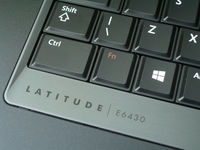Control key
| Names | Control, Ctrl, Cntl, Ctl |
|---|---|
| Symbol |
^ ✲ |
| Mac symbol |
⌃ |
| ISO/IEC symbol |
⎈ |
| X11 | "control" group, Control_L, Control_R |

The control key, typically written "Ctrl", is a modifier key with various uses across different systems. On German keyboards, this key is labelled "Strg", short for "Steuerung".
In the UNIX and Linux worlds, the control key is abbreviated to simply ^. This notation has carried over to Microsoft world, and Macintosh keyboards that use symbolic modifier labelling also use the caret symbol on the control key. Menu shortcuts on the Macintosh are always symbolic, and "^" is used to represent control in shortcuts, while PC systems prefer "Ctrl".
Uses
Keyboard shortcuts
The control key is best known for its use in entering keyboard shortcuts in Microsoft Windows. Common examples include ctrl+C (copy), ctrl+F (find), ctrl-A (select all) and ctrl-N (new document). In this sense, the control key on PCs is the equivalent of the command key on Macintosh computers. For legacy reasons, the Windows UI is inconsistent over shortcuts, and some still require the alt key to be held instead, mainly alt+F4 to close the current window (ctrl+F4 for MDI child windows and tabs).
SIGINT
In UNIX and Linux systems, ctrl+C generates SIGINT, the signal to interrupt the current process. This is used to cancel the current operation on the command line. The PC equivalent is ctrl+break, but Windows command-line tasks will also accept ctrl+C for this purpose as well.
ASCII control character entry
The classic purpose of the control key is to generate ASCII control characters. ASCII control characters are those codes from 0 (0x0) to 31 (0x1F) which exist for various in-band signalling and display control purposes instead of for character display. The only codes typically used today are 3 (0x03) for enter (on Macintosh computers, distinct from return), 8 (0x08) for backspace, 9 (0x09) for horizontal tab, 10 (0x0A) for line break (newline on UNIX and Linux), 13 (0x0D) for carriage return (newline on older Mac systems), and 27 (0x1B) for escape.
ASCII control characters can be entered on Latin alphabet keyboards by holding the control key, and pressing the letter of the basic Latin alphabet whose 1-based position corresponds with the character. For example, some computers will issue an audible alert ("bell") if ctrl+G is pressed, as G is the 7th character of the basic Latin alphabet, and ASCII 7 (0x07) is the code for an audible bell to be rung on a teletype, later generalised to an audible tone of some kind emitted from the console. Many systems accept ctrl+M instead of the return key, for example you can type "dir" followed by ctrl+M instead of return to list the current directory at the Windows command prompt. ASCII codes outside of the range 1-26 use symbols: the escape character is ctrl+[, and some computers accept ctrl-@ for code 0 (NULL).
